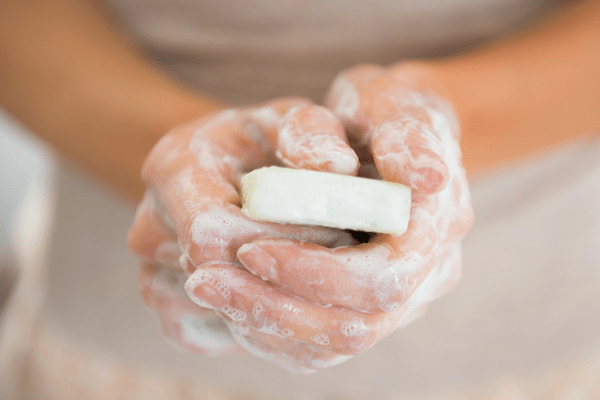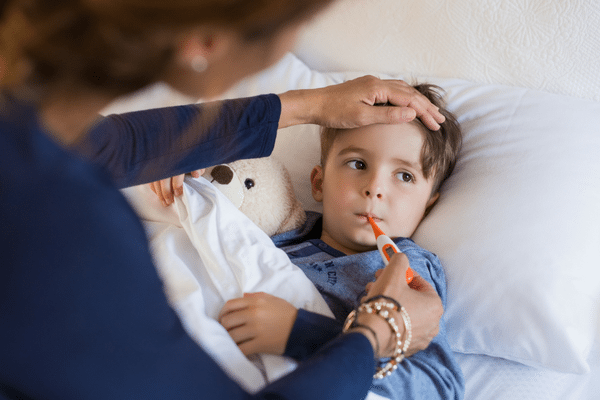As summer comes to an end, parents’ stressors turn from “How do I keep my kids from driving me crazy?” to “How do I keep my kids healthy?” With the start of the school year comes the onslaught of illnesses. From the flu to stomach viruses, on average, most children get between six and 12 illnesses a year.
A week before school started, my son came down with an intense and sudden fever, followed by a whole body rash. Normally, I would ride out the fever with OTC medications to ease the symptoms, a lot of fluids and a lot of sleep. But the sudden onset and intensity of the fever really had me worried, so we headed to the pediatrician’s office. Why? Because my gut told me something more was going on in my little guy’s body. Thankfully, our pediatrician was able to rule out any major illnesses that have been going around and we were able to keep everyone else in the house from getting sick!
Even though I worry every time one of my kids gets a cold or virus, I know that it can actually be a positive thing. According to Tracy Tyson, MD, a pediatrician with Orange Park Pediatrics, “It’s actually a good thing because kids need these viruses to build up the immune system. You’ll eventually get them at some point anyway, but these illnesses are much easier to tolerate as a child.”
Wolfson Children’s Hospital shared with us some key pieces of information to keep in mind as we navigate the school year.
How do you keep germs at bay?
Mark Bedard, DO, with Orange Park Pediatrics let us know that “germs are everywhere.” And, unless we live in a bubble, “we cannot avoid them altogether.”
Some ways to avoid spreading germs to others include:
- Letting others know when you or your child are sick. Don’t pretend everyone’s well since that could cause those around you to not take proper precautions to avoid your germs.
- Children need to learn how to sneeze and cough into their elbow or at least cover their mouths. Most respiratory bugs spread quite easily when airborne, while other germs like to rest on surfaces and can live there for up to 24 hours.
- Clean and disinfect all surfaces regularly.
- Wash your hands! Hand sanitizer is great and simple, but nothing beats washing with soap and water.
What can you do to strengthen immune system if you are sending your kid to daycare or school?
When you send your kids to school and daycare, exposure to germs and viruses is unavoidable. But, this isn’t necessarily a bad thing! Dr. Bedard explained, “Exposure to germs is actually the best way to build an immune system (hence the idea behind immunizations). There are numerous other theories that sound good, but little evidence to support them currently.”
Healthy living, along with immunizations, can keep bodies “fighting strong.” And, according to Dr. Bedard, healthy living includes getting plenty of sleep, maintaining a healthy weight and exercising regularly.
Why should a child stay home if he/she has a fever?
I’m a little old school in my thinking: if my child has a fever, he or she stays home for 24 hours after the fever has subsided without the use of OTC medication. But, according to Dr. Bedard, “Staying home only when a child has a fever (anything greater than 100.4 F) is a misconception.” Even though a child may not have a fever, he/she may still be contagious. Most kids are contagious several days before a fever and, most likely, a few days after.
So, why is a fever the benchmark for most schools and daycares?
“Fever is typically the easiest way to know if you or your child is sick. It is an obvious symptom that does not require the child to be verbal, it is not vague, and it is measurable via a thermometer at home. Parents need guidelines to know when to keep their children home and there has to be a line in the sand somewhere. That is why fever is chosen,” said Dr. Bedard.
What’s the difference between a viral infection and a bacterial infection? And, how can we treat them?
We spoke with Mark Toney, MD, a pediatric hospitalist at Wolfson Children’s Hospital and Nemours Children’s Specialty Care, to figure this one out.
“Infections are caused when different pathogens enter the body,” he explained. “The two most common types of pathogens are viruses and bacteria. Viruses are microscopic agents that live and replicate inside a human cell. Bacterial are single celled organisms that unlike human cells have a cell wall.”
Treating a viral infection versus a bacterial infection is very different. Most viral infections are cared for with OTC medications, while bacterial infections are treated primarily with antibiotics to “target the bacteria and either kill it or keep it from replicating,” said Dr. Toney.
When should I take my child to the pediatrician and when should I take him or her to the emergency room?
Always “trust your gut,” said Anthony Pohlgeers, MD, a pediatric emergency medicine physician with the Wolfson Children’s Emergency Centers. Your pediatrician can help diagnose your child as well as “provide treatment recommendations.” But, ultimately, “if you think it’s an emergency, don’t hesitate, and just call 911. You know your child best.”
 About the Author
About the Author
Brandie Andreoli made her way to Jacksonville via South Carolina, Massachusetts, and Pennsylvania. She met her Chicago-born husband while in college at Boston University in 2000. After six years of dating, he finally proposed to her in front of a classroom full of students…something they will never forget. They tied the knot in 2007 on Sanibel Island and from then on he decided to give up the cold to live in a place with sunshine and beaches once his training was finished. After six years of teaching, Brandie decided to change career paths and become a stay at home mom to two very energetic and strong willed kids. Her 5-year-old son could eat, sleep and breath all things Lego–especially if it is Batman related! Her 3-year-old daughter is the entertainer of the family and will do anything to put a smile on your face! To help balance the insanity of everyday life, Brandie started training and competing in triathlons last year. To say she isn’t addicted now would be an understatement. When Brandie isn’t spending time with her family or training, she loves to make a trip to the spa with a good book and glass of wine.



















